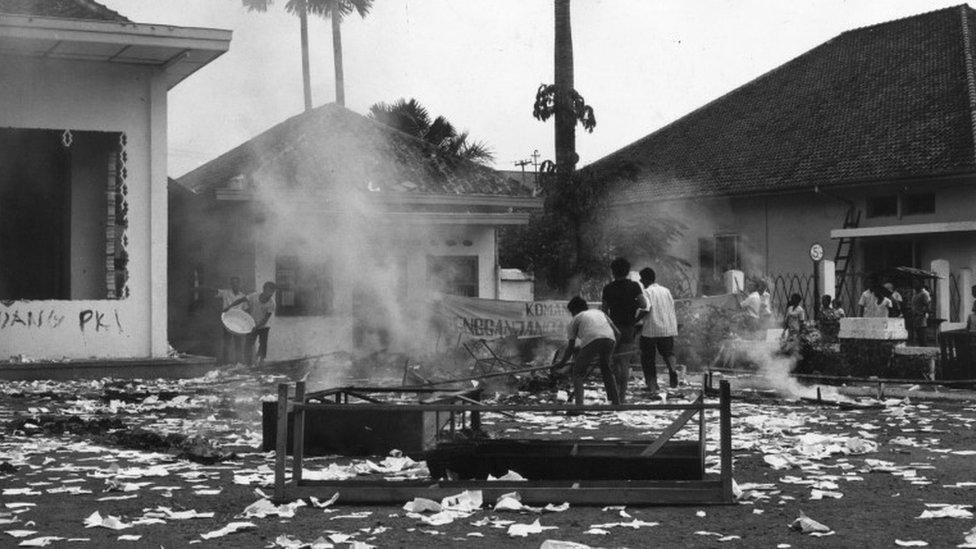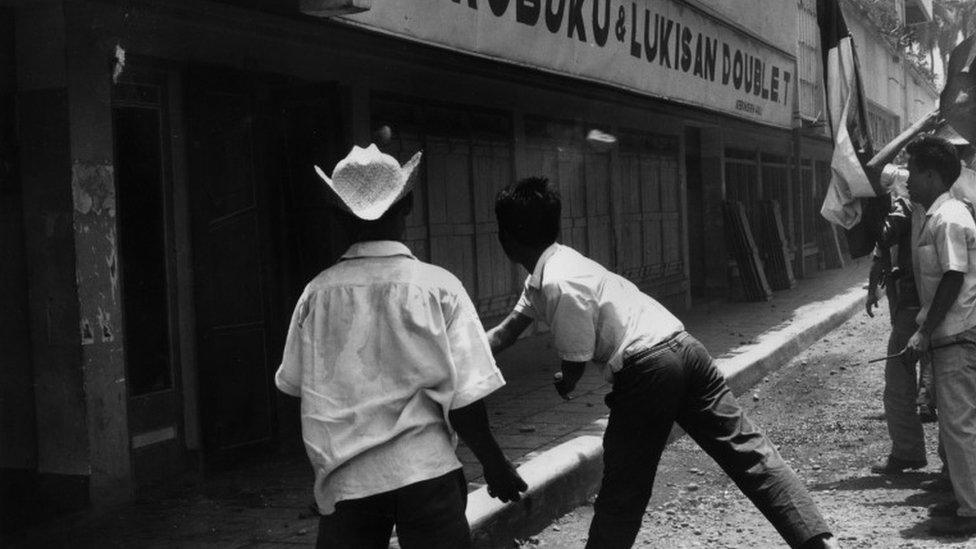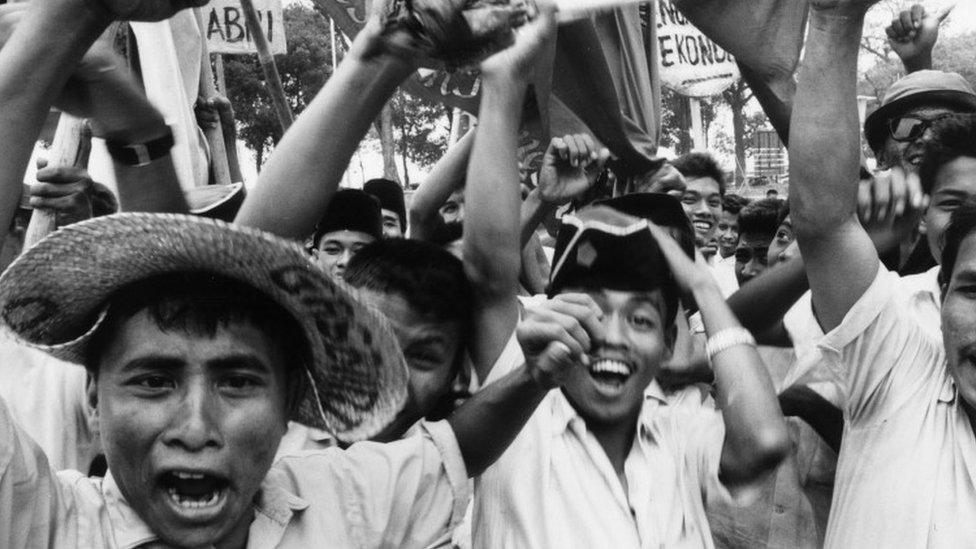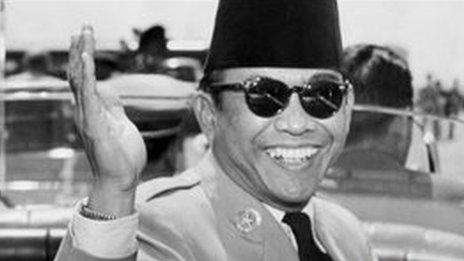Time running out for witnesses of Indonesia's darkest hour
- Published

Students burned down the headquarters of the Communist Youth Organisation in Jakarta after the failed coup
In the early hours of 1 October 1965, seven military units moved through the Indonesian capital, Jakarta, heading to the homes of seven of the most senior generals in the army.
Three were killed, three captured, and one, armed forces commander Abdul Haris Nasution, escaped, although his five-year-old daughter was fatally wounded by gunfire.
The three captured generals were taken to the main airbase in south Jakarta and killed, their mutilated bodies stuffed down a well.
This incident profoundly changed the course of Indonesian modern history, leading to one of the worst mass killings of the 20th Century, wiping out the world's third largest Communist Party, and bringing to power a general who ruled for three decades and brought the country firmly into the US orbit during the Cold War.
Yet 50 years later, these events remain poorly understood in Indonesia, with the real actors behind the move against the generals and their motives still unclear.
The shadow of what followed hangs over Indonesian society even today, with millions of families scarred by the trauma of massacres and brutal imprisonment, or by the guilt of having taken part.
'Crocodile hole'
I was based in Jakarta as the BBC correspondent in the last two-and-a-half years of the long rule of President Suharto, the general who emerged as the victor of the 1965 events.
Every year, TV channels would show films depicting the official version of those events, and ceremonies would be held by the well on the airbase, now known as lubang buaya or crocodile hole.

Communist-associated businesses, including this bookshop, were attacked after the failed coup
This narrative had the attempted coup led by the Indonesian Communist Party, or PKI. It portrays the party cadres as depraved and vicious, inflicting dreadful suffering on the six generals and one lieutenant who were killed.
But more than that, this Suharto doctrine painted communism as an evil, atheistic force that could sweep back over Indonesia if people were insufficiently vigilant - and of course, it justified the continued rule by his authoritarian New Order.
I knew quite a lot about those events, having worked for years for an Indonesian human rights group in London.
But under Suharto it was impossible to talk freely about them. In rural villages in Java I would occasionally be shown where the killings of suspected communists had taken place.
Younger Indonesians would ask their parents for me, but get only silence in response.

What happened in 1965?
Rivalries between the Indonesian military and the Communist Party came to a head when six generals were killed in an overnight attack by soldiers allegedly sympathetic to the communists
A group of officers led by a colonel in President Sukarno's palace guard was accused of trying to launch a coup
General Suharto led bloody anti-communist purges in which hundreds of thousands of suspected leftists were killed
Many more were detained and imprisoned without trial
In 1966, President Sukarno was forced to hand emergency powers to Gen Suharto, who took over as president the following year, ruling Indonesia for 31 years

I knew a few people whose lives had been blighted by the 1965 upheavals - unable to study at university, because a grandmother had been tainted by association with a communist group; unable to get a proper job because of once being imprisoned as a tapol, or political detainee.
Until 1995, former prisoners - and there had been 100,000 of them, held in appalling conditions, without trial, between 1965 and 1979 - had their national identity cards marked with the letters ET for ex-tapol.
To this day in Indonesia, ex-tapols complain about discrimination.

Gen Suharto, who instigated the purges, went on to rule Indonesia for 31 years
The fall of Suharto in a sudden burst of people power in 1998 lifted the pervasive fear, which had silenced all discussion of the 1965 events until then.
It has allowed survivors of the killing fields to learn for the first time that the official version they were fed was, in fact, largely propaganda.
Back in 1965, Indonesia was in a state of high tension. Its embryonic parliamentary system had been replaced in 1959 by the single leadership of the country's mercurial founding president Sukarno.
Rebellions and attempted coups had been put down; the country was in a constant state of near conflict; it had fought for, and won control of Dutch-administered New Guinea. Its troops were fighting British forces protecting the newly created federation of Malaysia.
Sukarno railed against US-led imperialism, and took Indonesia out of the UN. The economy was near to collapse.
Feeble and poorly planned
In this ferment, the PKI, with three million members and perhaps 20 million sympathisers, pushed for more influence, while increasing its power in populous Java by promoting land redistribution, sometimes violently, usually at the expense of orthodox Muslim landowners.
The army, by then enjoying US training and a prominent role in state industry, saw the party as a threat, especially its efforts to win converts in the ranks. With Sukarno's health failing, a showdown seemed inevitable.
But the attempted putsch against the top generals was feeble and poorly planned.

Students staged protests to demand the Communist Party be banned
Led by middle-ranking leftist officers, it had the support of only a few military units. The PKI leader, DN Aidit, was involved in the planning, but the most important role was played by a mysterious agent called Sjam Kamaruzaman, who headed a little-known PKI unit, the Special Bureau, which aimed to infiltrate the ranks of the armed forces.
But most of the party was ignorant of the plot, and unprepared to take advantage of it.
Inexplicably, the plotters ignored Gen Suharto, who commanded the important Kostrad strategic reserve unit.
After Suharto's resignation in 1998, the only surviving plotter, Colonel Latief, explained that he had informed Suharto of their plans days before, and understood him to be on their side. It was a disastrous miscalculation.
Suharto led a swift and efficient counter-coup, dispersing the plotters within 24 hours. The PKI leaders were rounded up, some of them, like Aidit, summarily executed, others put through tribunals that saw many more executed later.
The army took control of the media, whipping up anger against the PKI.
And then the killings began. Within four months, at least 500,000 had died.
In 2001, I interviewed a man in the East Java town of Pasuruan, who took part in the killings.
We would march them down to the pier, he said, club them to death, and roll their bodies into the sea. They did not resist, and he spoke of hundreds dying at that spot.

Abdurrahman Wahid, who later became president, said he dared not encourage the fall of Suharto, for fear of prompting communal violence
Like most of the inhabitants of that part of Java, he was a devout supporter of Nahdlatul Ulama (NU), a traditionalist Muslim movement with tens of millions of followers.
They saw the PKI as godless rivals and were easily prompted to violence against its supporters. Later the charismatic leader of NU, Abdurrahman Wahid, a reformist Muslim who became president in 1999, used to tell me his knowledge of the terrible bloodshed carried out by NU followers in 1965 was the main reason he dared not back moves to unseat Suharto, for fear of further communal violence.
But we also now know that the mass killings usually started only after the arrival of military special forces, dispatched by Suharto to enforce his regime's authority. The army played a central role.
Those forces were lead by Colonel Sarwo Edhie, who happened to be the father-in-law of Susilo Bambang Yudhoyono, the fourth president after Suharto, who stepped down only in 2014.
All of which helps to explain why, 17 years after the fall of Suharto, there is still no real debate about the events of 1965.
The military, which remains a powerful institution, has much to lose by having its murky role publicly discussed.
Millions of people who took part in the killings do not want to talk about them.
And the decades of intense demonisation of the PKI make it very hard for its sympathisers to speak out.
Mass graves excavated
The astonishing twin films made recently by American director Joshua Oppenheimer, in which perpetrators and victims re-live their roles and their memories of the 1965 killings, have for the first time brought those events wider global attention.
They have been shown in Indonesia, and provoked reactions ranging from anger to bewilderment and, among a few Indonesians, curiosity to know more.
In some areas, family members have started excavating known mass graves in search of human remains.
A "people's tribunal" has been set up by activists in the Netherlands to document the human rights abuses of that period.
Indonesia's president, Joko Widodo, has promised a state-sponsored inquest, but has so far done little, and has refused to apologise to the victims on behalf of the state.
With every year, fewer of those who witnessed the terrible massacres are alive and able to testify.
Time is running out for a full accounting of the horrors of that time, and a chance to settle the ghosts of Indonesia's unhappy history.
- Published17 April 2019
